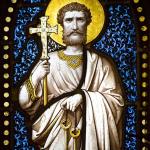
Genesis 10 [all] (RSV) These are the generations of the sons of Noah, Shem, Ham, and Japheth; sons were born to them after the flood.
[2] The sons of Japheth: Gomer, Magog, Madai, Javan, Tubal, Meshech, and Tiras.
[3] The sons of Gomer: Ash’kenaz, Riphath, and Togar’mah.
[4] The sons of Javan: Eli’shah, Tarshish, Kittim, and Do’danim.
[5] From these the coastland peoples spread. These are the sons of Japheth in their lands, each with his own language, by their families, in their nations.
[6] The sons of Ham: Cush, Egypt, Put, and Canaan.[7] The sons of Cush: Seba, Hav’ilah, Sabtah, Ra’amah, and Sab’teca. The sons of Ra’amah: Sheba and Dedan.
[8] Cush became the father of Nimrod; he was the first on earth to be a mighty man.
[9] He was a mighty hunter before the LORD; therefore it is said, “Like Nimrod a mighty hunter before the LORD.”
[10] The beginning of his kingdom was Ba’bel, Erech, and Accad, all of them in the land of Shinar.
[11] From that land he went into Assyria, and built Nin’eveh, Reho’both-Ir, Calah, and
[12] Resen between Nin’eveh and Calah; that is the great city.
[13] Egypt became the father of Ludim, An’amim, Leha’bim, Naph-tu’him,
[14] Pathru’sim, Caslu’him (whence came the Philistines), and Caph’torim.
[15] Canaan became the father of Sidon his first-born, and Heth,[16] and the Jeb’usites, the Amorites, the Gir’gashites,
[17] the Hivites, the Arkites, the Sinites,
[18] the Ar’vadites, the Zem’arites, and the Ha’mathites. Afterward the families of the Canaanites spread abroad.
[19] And the territory of the Canaanites extended from Sidon, in the direction of Gerar, as far as Gaza, and in the direction of Sodom, Gomor’rah, Admah, and Zeboi’im, as far as Lasha.
[20] These are the sons of Ham, by their families, their languages, their lands, and their nations.
[21] To Shem also, the father of all the children of Eber, the elder brother of Japheth, children were born.[22] The sons of Shem: Elam, Asshur, Arpach’shad, Lud, and Aram.
[23] The sons of Aram: Uz, Hul, Gether, and Mash.
[24] Arpach’shad became the father of Shelah; and Shelah became the father of Eber.
[25] To Eber were born two sons: the name of the one was Peleg, for in his days the earth was divided, and his brother’s name was Joktan.
[26] Joktan became the father of Almo’dad, Sheleph, Hazarma’veth, Jerah,
[27] Hador’am, Uzal, Diklah,
[28] Obal, Abim’a-el, Sheba,
[29] Ophir, Hav’ilah, and Jobab; all these were the sons of Joktan.
[30] The territory in which they lived extended from Mesha in the direction of Sephar to the hill country of the east.
[31] These are the sons of Shem, by their families, their languages, their lands, and their nations.
[32] These are the families of the sons of Noah, according to their genealogies, in their nations; and from these the nations spread abroad on the earth after the flood.
The “Table of Nations” in Genesis 10 is not just a purely mythical and ethnocentric story made up by an early Hebrew tribesman many hundreds of years “after the [alleged] facts.” It exhibits throughout a genuine knowledge of ancient Near East geography and culture.
Egyptologist, archaeologist, and evangelical Protestant, Kenneth A. Kitchen, probably the greatest living biblical “maximalist” archaeologist, in his book, On the Reliability of the Old Testament, Grand Rapids and Cambridge: William B. Eerdmans Publishing Company, 2003), stated in summary:
Gen. 10 . . . forms a “verbal atlas” of absorbing interest . . . Such verbal atlases, but not expressed genealogically, are known in Babylonian lists from third-millennium Mesopotamia, in Ebla (for north Syria), in Egypt in the Execration Texts (early second millennium, for Levant and Nubia). and in the great topographical lists of alleged “conquests” and foreign subjects or contacts (middle to late second millennium), for Nubia, the Levant, sometimes out to the Aegean, and even Mesopotamia eastward. . . .
[I]n the late second and early first millennia alike, the earliest Hebrew geographers had a wide range of places and peoples in their tradition, and of which they had gained knowledge. . . .
Where Egypt, Mesopotamia Hatti, or Ugarit had kings, the Hebrews had genealogies. (pp. 430-431, 438-440)
Dr. Kitchen then sets out to do “a broad overview” or “flying tour” (p. 436) of the Table of Nations, with details “consigned to the footnotes”. I will include the information in those footnotes, if I think they help my overall case and presentation to a “popular” (as opposed to merely academic) audience.
Yawan
From a Levantine (and even Egyptian) point of view, the groups and places under Japhet are entirely northern, in location or origin — northeast, north, northwest — in Anatolia/northwestern Iran, and the Aegean/eastern Mediterranean (and beyond). Yawan [Javan above, in RSV] covered the Greeks (Mycenaeans onward) [Footnote 16: Javan is identified as the Ionians (east Greeks), possibly the Ym’n of the Ugaritic texts . . .] (Kitchen, 436, 592)
The 1901 Jewish Encyclopedia (“Yawan”) elaborates:
The word corresponds to the Greek Ἰων, the plural of which is Ἰονες, with the digamma between the a and o (see Homer’s “Iliad,” 13:685). The Greek name denotes the Ionians, settled, when the list of Genesis was written, on the mainland of Greece and on the islands of the Ægean Sea as well as along the coast of Asia Minor. The Greeks were designated by this name in Assyrian (“Ya-wa-nu” [Greece], “Yawnai” [Greek]; . . .) and in Old Persian, and the name was used in this sense by the Syrians, the Arabs, and the Egyptians. The question is still open whether in the Old Testament “Javan” connotes the Greeks, in keeping with this usage of other ancient peoples, or merely the Ionians proper.
Tubal and Togarmah
Tubal and Togarmah were Anatolian places. [Footnote 17: Tubal goes back to the Tibar of Naram-Sin (twenty-third century), then the Tapala of the fifteenth century and Tapala of the fourteenth/thirteenth in Hittite sources . . .] [Footnote 18: Togarmah is older Tegarama and Takarma in Anatolia, in nineteenth century Old Assyrian sources . . ., then fourteenth/thirteenth-century Hittite sources . . .] (Kitchen, 436, 592)
Meshech
Into that region [Tubal and Togarmah] came the Meshech (Mushki, Phrygians) . . . [Footnote 19: Meshech is the Mushki or Mushku of Assyrian texts . . ., from Tiglath-pileser I (ca. 1100) onward . . .] (Kitchen, 436, 592)
Gomer
Into that region [Tubal and Togarmah] came . . . Gomer (Cimmerians) . . . [Footnote 20: Gomer is the Gimirrai of the Assyrian texts, the Cimmerians of classical sources, who appear in 714 under Sennacherib . . .] (Kitchen, 436, 592)
Ashkenaz
Into that region [Tubal and Togarmah] came . . . Ashkenaz (Scythians) . . . [Footnote 21: Ashkenaz are the classical Scythians, the Assyrian Ashkuza/Ishkuza . . ., in the seventh century under Esarhaddon . . .] (Kitchen, 436, 592)
Madai
Into that region [Tubal and Togarmah] came . . . the Madai, Medes in Iran. [Footnote 22: Madai is the Medes, attested by texts of Shalmaneser III (835 B.C.) and onward . . .] (Kitchen, 436, 592)
Elishah and Kittim
Elishah and Kittim are most likely parts of Cyprus (Alasia, a kingdom; Kition, a town whose name found wider use). [Footnote 23: Elishah goes well with the late second-millennium of Alashia of cuneiform sources and Egyptian Irs, Alasia . . .; it is probably a kingdom in Cyprus; it appears to go back to the early second millennium . . .] [Footnote 24: Kittim is to be compared with Kition, a settlement in Cyprus, archaeologically well attested from the late second millennium, with traces going much further back (Early Bronze, ca. 2000) . . .] (Kitchen, 436, 593)
Tiras
Tiras may be the Tursha of the thirteenth/twelfth-century Sea Peoples, and eventually linked with the (E)truscans who ended up in Italy [Footnote 25: . . . may be . . . the Sea Peoples group under Merenptah in 1209, whom some would identify further with the . . . classical Tyrsenoi . . .] (Kitchen, 436, 593)
The above names are classified as “sons of Japheth.” The “sons of Ham” are a much larger group. Kitchen says of them: “The basic coverage is northeast Africa, Arabia/Levant, and Mesopotamia, with outliers to the north and east” (p. 436).
Cush
Cush A is modern Nubia, the Nile Valley and its deserts south from the First Cataract, into north Sudan, and to the Red Sea west coast. By transference, Cush C (linked with Arabia) may represent the close links that existed in early antiquity across the Red Sea between Arabia and Africa . . . Cush B is in western Iran, and may be represented by the Kashshu, Kassites, who gave a 500-year -long dynasty to Babylonia during the second half of the second millennium. [Footnote 26: Cush A is the Kush of the Egyptian texts . . . Its original scope (early second millennium) was restricted to Upper Nubia . . . Cush B is the Kashshu, or Kassites, from the Iranian mountains and valleys immediately east of Babylonia. Cush C, the “father” of Arabian entities (10:7), is very likely simply an extension of Cush A, East Africa south of Egypt . . .] (Kitchen, 436-437, 593)
Mizraim and Naphtuhim
Mizraim [as in the KJV; Egypt in RSV], of course, is Egypt, including the northern Delta (Naphtuhim) . . . she is still Misr today, in Arabic. [Footnote 27: . . . Misir, Mizru, Musri of cuneiform sources from the mid-second millennium onward . . .] (Kitchen, 437, 593)
Pathros
Pathros [Pathrusim in RSV] has long been recognized as . . . “the Southland,” Upper Egypt south of the Delta, a term of New Kingdom origin and attested (as Paturesi) in Assyrian texts . . . (Kitchen, 595)
Lehabim and Put
Lehabim and Put [are] in east Libya. [Footnote 28: Put is attested under Osorkon II in Egypt [r. 872-837 BC] (Pydw) on his Tanis statue . . . It recurs as Pwd(y)/Pwt in a series of amuletic “divine” decrees of the tenth century onward . . .] (Kitchen, 437, 593)
Canaan, Zemarites, Arkites, Sinites, Arvadites, Hamathites, Girgashites
This is an older “Canaan,” embracing the cities of the Mediterranean coast from Sidon up via Sumur (Zemarites) and Irqata (Arkites) to Arvad and Siyannu (Sinites) near Ugarit, plus Hamath inland on the river Orontes, and reaching down to Jebus (Jerusalem). [Footnote 29: Canaan is Palestine west of the Jordan from the Negev in the south to the Litani gorges behind Tyre in the north during the fifteenth century and later. Hebrew occupation added Gilead and Bashan east of the Jordan River and Galilee for a time. In the third/early second millennium, it applied to Phoenicia (south of Ugarit) from Siyannu to Sidon, and inland to Hamath (10:15) . . .] (Kitchen, 437, 593-594)
The Arkites inhabited the seaside town of Irqata (later, Arqata), from at least the early second millennium (archaeological traces, Tell Arqa, Execration Texts) through the late second millennium . . . The Sinites are of Siyannu, known well from the archives of its immediate northern neighbor, Ugarit . . . Arvad (modern Ruad) was home to the Arvadites, from the third millennium to Roman times . . . The Zemarites were based at Sumur, classical Simyra (now Tell Kazel), just north of the mouth of the Eleutheros River (Nahr el-Kebir). Archaeologically, , life began there in the Middle Bronze Age (early second millennium), and Sumur features incessantly in the Amarna letters (fourteenth century) . . and recurs in Egyptian sources (fifteenth, thirteenth centuries . . .) . . . Girgashites are known indirectly in the late second millennium in two personal names at Ugarit, Grgsh and Bn-grgsh . . . (Kitchen, 596)
Caphtor
Caphtor is the Kaptara of cuneiform sources, Egyptian Keft(i)u, and is over in Crete, as the evidence of Egyptian tomb scenes (Minoans and Mycenaeans) shows clearly. From over the Mediterranean came the Philistines. (Kitchen, 437)
See also my related article, Pearce’s Potshots #33: No Philistines in Moses’ Time?
Sidon
Sidon goes back to the Early Bronze Age in the third millennium, and recurs in Egyptian sources in the late second millennium, e.g., in the Amarna letters . . . (Kitchen 595-596)
Shinar, Assyria, Nineveh, Calah
Mesopotamia appears under its “western” name, Shinar, and here has with it such famous places and regions as . . . Assyria with Nineveh and Calah. (Kitchen, 437)
Babylon
Babylon, because of high groundwater, cannot be dug right back through time; but Sargon is rumored to have destroyed it (twenty-fourth-twenty-third century), and Sharkalisharri, a successor, built two temples there (twenty third-twenty-second century), while Shulgi of the Third Dynasty of Ur stole from Marduk‘s temple there (twenty-first century). (Kitchen, 595)
Erech
Erech (Uruk) (Sumerian Unug), was a very ancient city in south Babylonia. (Kitchen, 595)
Akkad
Akkad [Accad in RSV], was the famed (but still unlocated) capital of Sargon the Great and his dynasty in the twenty-fourth-twenty second centuries . . . (Kitchen, 595)
Havilah
Havilah covers west and north Arabia, probably broadly from Hawlan to the edges of Midian, Edom, and Sinai. [Footnote 30: . . . may take its name from Sabaean Hawlan . . .] (Kitchen, 437, 594)
Raamah
Raamah is commonly taken to be Ragmatu (the later Najran, north of Main and Sheba). [Footnote 31: Raamah . . . is frequently identified with the Ragmatum (now Al-Ukhdud) in the oasis of Najran just north of Yemen, named in the Old South Arabian inscriptions . . . of the seventh or fifth century . . .] (Kitchen, 437, 594)
Dedan
Dedan was a kingdom based on Al-Ula oasis in northwest Arabia, mentioned by Assyria and in Old Arabian texts. (Kitchen, 437)
Sheba, Seba, Sabta, Sabteca
Sheba is the famous kingdom in ancient Yemen, based on Marib, from at least circa 1100 onward. Seba may be an outlier of Sheba, in East Africa (not certain), while Sabta may be Shabwa(t), capital of Hadramaut . . . Sabteca may be in the same area. (Kitchen, 437)
Saba (in some older translations of Genesis 10:28) is simply a variant of Sheba.
Kitchen proceeds to comment on the “sons of Shem”:
Elam
Elam (in west-southwest Iran) was linguistically non-Semitic throughout, but was heavily influenced by, and involved with, her Mesopotamian neighbors at all periods.
. . . from the third millennium down to the seventh century . . . (Kitchen, 438, 597)
Hazarmaveth
Hazarmaveth is ancient Hadramaut, the kingdom east of Sheba and Qataban that held the famous incense-growing lands of Dhofar. (Kitchen, 438)
Ophir
Ophir was most likely the south end of Havilah, in gold-producing western Arabia. (Kitchen, 438)
Aram
Aram is the Aramaeans attested from the fourteenth century, and possibly earlier in the area of the west bend of the Euphrates, then later in Syria west and south of there. [Footnote 40: . . . The name is first securely attested in Egyptian sources under Amenophis III (ca. 1380) and Merenptah (ca. 1200) . . .] (Kitchen, 438, 596)
See also my related article, Arameans, Amorites, and Archaeological Accuracy.
Lud
Lud . . . may be Anatolian, Lydia. (Kitchen, 438)
Asshur
Asshur is the oldest Assyrian capital, Ashur, from which the kingdom took its name, and was first founded circa 2500 . . . (Kitchen, 597)
***
Photo credit: [public domain / Max Pixel]
***
Summary: Eminent Egyptologist & archaeologist Kenneth A. Kitchen leads us through the fascinating historical & geographical facts gleaned from the famous “Table of Nations” (Gen 10).













